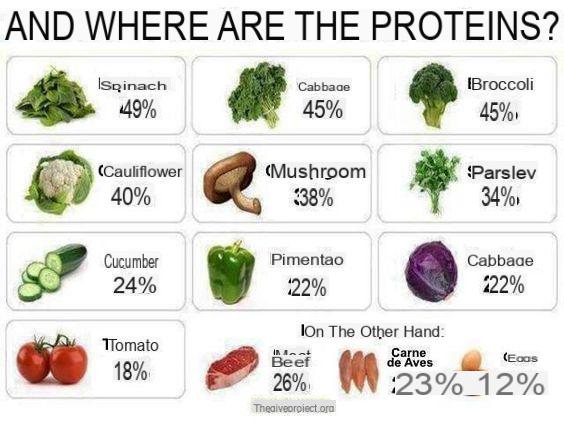
Plant and animal proteins: qualitative differences
Le protein they are the "building blocks" of our body, fundamental for all biological processes related to life, such as tissue repair, the production of antibodies, the synthesis of hormones and enzymes. They consist of amino acids, which are divided into essential e not essential.
Our body is unable to synthesize essential amino acids, for this reason it is important to take them through food. Both plant-based and animal-based foods are sources of protein.
In this regard, we often read that “legumes are the richest vegetable source of proteins in nature, even surpassing meat. To those who tell you that they need a good steak for their protein intake, you can answer that a plate of cereals and lentils wins over everything ”.
Legume proteins they cannot replace those of the flesh. Not only do they contain 3 times less protein than meat for the same weight, but these proteins are neither of good quality nor easily absorbed.
It is not only the amount of protein we need that is important but also the quality, which depends on the amino acids present in proteins.
When a protein contains the essential amino acids in the right proportions required by the human body, it is said to have a high biological value.
Animal protein sources, as meat, poultry, fish, eggs, XNUMX cups milk, cheeses and yogurt, provide high biological value proteins.
Vegetables - legumes, cereals, nuts, seeds and vegetables - provide proteins with a low biological value, as one or more amino acids are present in insufficient quantities.
To solve this lack, the combination of cereals and legumes is recommended, as the essential amino acid deficiencies of cereals are covered by those of legumes and vice versa.
An example are pasta and beans or rice and peas. By following a varied and well-planned diet, trying to diversify the vegetable protein sources as much as possible, it is possible to obtain the nine essential amino acids in the right quantities, although not always in the same meal.
Possible substitutes for meat
I beans, broad beans, lentils, chickpeas, peas, dried or fresh, they are rich in proteins (dried beans and peas contain 20-25% of proteins, 6-7% if they are fresh), low in fats, have a good content of vitamins (in particular folate, Vitamin B1 and niacin, of vitamin A and C in fresh legumes, etc.), minerals (calcium, phosphorus, potassium, etc.) and of fibers, so they help reduce LDL cholesterol, and have a low glycemic index.
The main drawback of legumes is to reduce the availability of some minerals (calcium, phosphorus, iron, zinc) and as regards their food consumption it is recommended to keep them for 10-12 hours, before cooking, soaking by changing the water a couple of times adding a teaspoon of baking soda or the 'alga Kombu.
Furthermore, prolonged cooking is recommended (at least 1 hour for lentils and dried peas, at least 2 hours for beans and chickpeas) e cooking in a pressure cooker, which reduce the content of anti-enzymes (substances that slow down the digestion of proteins) and antivitamins C and E. Therefore, another important warning is to never use the cooking water of legumes, in which these antinutrients remain using clean water for cooking and not soaking water for example.
Also soy derivatives (tofu and tempeh) are valid alternatives: both very rich in vegetable proteins with 8/10 grams per 100 grams. Another interesting food is the seitan, obtained from the processing of wheat flour.
Its values are very close to those of meat, but it does not contain cholesterol and saturated fats. Real imitations of the flesh are also created with seitan; the dough, thanks to the gluten contained in it, can take any shape even that of sausages or steaks. Depending on the spices used in the preparation, it can have a more delicate or stronger flavor.
Iron in vegetarian diets
Heme iron makes up only 40% of the iron in meats, while non-heme iron constitutes 60% of the iron contained in meat and almost all of the iron contained in vegetables.
Unlike the iron eme, more easily absorbed, the iron in form non-eme it is much more sensitive to both substances and practices that inhibit (phytates; calcium; tea; some herbal teas; coffee; cocoa; some spices; fibers; calcium from milk and derivatives) than to those that facilitate (vitamin C and other organic acids found in fruit and vegetables; leavening, sprouting and fermentation; pre-cooking soaking) the absorption of iron from food.
The recommended amount of iron, to be introduced daily with an omnivorous diet to replace losses, is 10 mg and 18 mg respectively for adult men and women.
Vegetables are not a good food source for iron, unlike calcium (apart from some herbs and spices, which are used in small quantities but which have an iron content that has nothing to envy to that of offal). Spinach, in particular, certainly does not represent the optimal model of vegetable food rich in iron: they are placed in a low position for the content, and are also extremely rich in phytates and oxalates, which tend to capture iron by reducing its absorption.
Instead, iron should be sought in other plant foods which, especially if taken together with a little lemon or citrus juice, I am able to supply all the necessary quantity without any problem!
At the top of the ranking stands the bitter cocoa powder (100g of product contain 14,3 mg of iron).
Tips for an optimal vegetarian diet
Thinking of switching to a vegetarian diet must be a thoughtful and logical choice: vegan or vegetarian are not necessarily synonymous with health and / or weight loss.
Better to avoid, therefore, of improvise food protocols vegetarians found on the web and rather rely on a professional figure who can provide all the information appropriate to their specific nutritional needs.


























